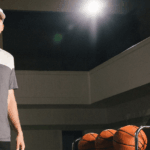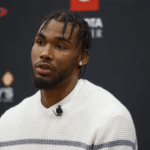Recent Posts
Dwayne “The Rock” Johnson Surprises YMCA Families at Walmart
December 20, 2025James Harden Surprises Dorsey High Students
December 20, 2025The Highest-Paid Players Heading Into the 2024 WNBA Season
Women’s basketball is rising with the arrival of the 2024 WNBA draftees such as Caitlin Clark, Cameron Brink, Kamilla Cardoso, Angel Reese, and Aaliyah Edwards. All are looking to leave their marks not only in the WNBA, but in women’s basketball as a whole. However, the optical that is still hanging over the WNBA like a dark cloud is the discussions surrounding the financial outlook in the WNBA.
Yes, the incoming class will be able to subsidize their WNBA salaries with the NIL deals that they were able to acquire during their time in college.
“I think it’s been a really important to the ecosystem. I think the reality of it is that the college platform is huge you could even make an argument at times it’s bigger than the WNBA. I mean viewership records in the NCAA tournament would would definitely suggest that it’s been around longer. I think March Madness itself is such a powerful platform that these college kids get to play on and so the way I always viewed MIL and I know college coaches probably hated it when it first started. But the way I always viewed it was you had these players I would say a couple years ago when you had the Paige Bueckers, the Hailey Van Lith, and the Angel Reese’s when they were in high school. I started to see like, oh they have huge followings,” said Sue Bird.
“You’d open up social media and they’re already in like the hundreds of thousands close to million followers. I mean now they they’ve all exceeded that you know by a lot I was about to say by a billion it doesn’t do math. You’ve exceeded that and I think what the NIL deals do is it attaches obviously Brands to them, and it also puts them on this platform in an even different space. The platform was big as it was in college basketball, now when they have Partnerships with huge brands household name brands it makes it even bigger.”
Caitlin Clark since announcing her intentions to leave Iowa to enter the WNBA Draft and eventually becoming the number one pick by the Indiana Fever. Receiving an offer of $15 million for the Big 3, which would’ve according to Co-Founder Jeff Kwatinetz consisted of “Ten million dollars of salary over two years, a percentage of team ownership worth millions, fifty percent of merchandising revenues from her name and likeness, and ownership of a BIG3 documentary with a seven-figure advance.”
“In total, we’re talking fifteen million dollars or more to merely play a ten-game season.”
This would also allow her to fulfill her obligation to the Fever and the WNBA. Clark also recently signed a eight year deal with Nike worth $28 million. In the WNBA this year will be $76,000 and 330,000 over the next four years, according to Spotrac.
Over the last five years or so the disparity between salaries in the NBA and WNBA has been a hot topic. The NBA players are receiving life changing contract, while WNBA players compensation is modest at best. However, the WNBA will make more process once they secure their television. Seattle Storm owner Lisa Brummel spoke on the media right deals and the momentum from the NCAA tournament.
“Yeah, I think certain certainly expansion conversations the media rights deals that are uh coming along in the future will be two huge steps toward the growth of the league. But, I think even for the teams that exist today coming out of just an NCAA tournament that was absolutely on fire and flowing right into the W season which even before we play our first game is booming,” said Brummel.
“I think we’re right in The Sweet Spot of where Women’s Basketball and women’s sports can be so I think you can pick one or the other other activity and they both will Foster growth but there’s a lot of organic growth that’s happening people are finally catching on that this is really really an amazing product and you see people getting on board in droves, which is wonderful.”
“I echo that. I think for a long time, I’ve been saying and definitely now that the media rights deal is was probably going to be one of the most important moments in WNBA history. I think the only thing I would add that’s been really wonderful to see is a lot of the conversation and optics around the league has changed in the last couple years, said Sue Bird.“Especially in the last couple months and that’s just I think outside looking in whether I was I’m a player or I’m in the ownership Group. Whatever it is it’s just really wonderful to see that because we’ve always known it right, but the ways that people were talking about our league, talking about players in our league. Talking about women’s basketball as a whole, that didn’t always add up, and so it’s just really wonderful to see that change. Because I do think Optics plays a role in which people view us and and view the league.”
- Jackie Young, Las Vegas Aces Annual Salary: $252,450 As the first overall pick in 2019, Jackie Young has been instrumental in the Las Vegas Aces’ consecutive WNBA championships. Her prowess on the court earned her a historic two-year extension, making her the highest-paid women’s basketball player to date.
- Jewell Loyd, Seattle Storm Annual Salary: $245,508 Selected as the top prospect in 2015, Jewell Loyd’s scoring prowess and championship pedigree have solidified her status as one of the league’s elite players. Seattle rewarded her contributions with a lucrative two-year extension.
- Kahleah Copper, Phoenix Mercury Annual Salary: $245,059 Kahleah Copper’s journey from bench player to WNBA Finals MVP exemplifies perseverance and talent. Despite a mid-season trade, her stellar performance secured her a spot among the top earners for the 2024 season.
- Arike Ogunbowale, Dallas Wings Annual Salary: $241,984 A standout at Notre Dame, Arike Ogunbowale’s transition to the WNBA has been seamless, earning her multiple All-Star nods and a lucrative three-year extension with the Dallas Wings.
- Diana Taurasi, Phoenix Mercury Annual Salary: $234,936 Despite her veteran status, Diana Taurasi continues to defy age, boasting an illustrious career spanning two decades. With numerous accolades to her name, including WNBA championships and MVP honors, Taurasi remains a force on the court.
- Natasha Howard, Dallas Wings Annual Salary: $224,675 Natasha Howard’s defensive prowess and championship pedigree have made her a valuable asset to any team she joins. With three WNBA titles under her belt, Howard’s impact extends beyond the stat sheet.
- Erica Wheeler, Indiana Fever Annual Salary: $222,154 From undrafted to top earner, Erica Wheeler’s journey is a testament to perseverance and determination. Her rise to prominence showcases the depth of talent within the WNBA.
- Brionna Jones, Connecticut Sun Annual Salary: $212,000 Brionna Jones’ evolution into one of the league’s premier bigs highlights the importance of development and patience. With multiple accolades to her name, Jones continues to make her mark with the Connecticut Sun.
- Skylar Diggins-Smith, Seattle Storm Annual Salary: $211,343 Skylar Diggins-Smith’s impact on women’s basketball spans over a decade, earning her numerous accolades and a spot among the league’s top earners. Her recent two-year deal with the Seattle Storm solidifies her status as a key contributor.
- Alyssa Thomas, Connecticut Sun Annual Salary: $209,000 Alyssa Thomas’ defensive prowess and versatility have made her a cornerstone of the Connecticut Sun’s success. With multiple All-Star nods and defensive honors, Thomas continues to be a force on both ends of the court.
As the WNBA continues to grow and evolve, discussions surrounding player compensation will continue to be a topic of interest moving forward.











Leave a comment